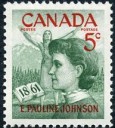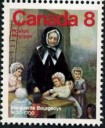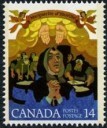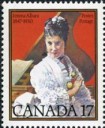
Women have been appearing on Canadian stamps since June 1851 when a 12-pence black stamp was issued featuring reigning monarch Queen Victoria. This is only normal since reigning monarchs have always been front and center on any country’s postal issues. But what about stamps commemorating ordinary women and their accomplishments? Which Canadian women have been honored by being commemorated on a Canadian postal issue? This series of articles will highlight the 59 famous Canadian women whose actual face appears on individual Canadian stamps (another series will highlight those women whose accomplishments are featured on the stamp, but who do not appear themselves). Part one concentrates specifically on those stamps issued from 1961-1992 (1961 was the first year that a woman other than the Queen appeared on a Canadian stamp).

Pauline Johnson
Pauline Johnson (1861–1913), was a Canadian poet. She was born in Ontario to an English mother and Mohawk father. While she was growing up her family was relatively well off and she was encouraged to study both sides of her ancestry in depth. Her poetry was only well recognized after her death from breast cancer and she never really benefited financially from her artistic works. She was the first woman (other than a monarch) and Native American to be commemorated on a Canada stamp.

Jeanne Mance
Jeanne Mance (1606–1673) was a settler of New France and the founder of the Hôtel-Dieu hospital in Montreal. She was born in France but settled in the New France colony when she realized her vocation was to be a missionary. She braved the harsh climate and Iroquois attacks in order to establish a secure colony and hospital in the new world, specifically in the new city of Montreal. She made several trips back to France to petition for financial help and more volunteers to work in her hospital. Jeanne was tireless in her efforts to help women and children adjust to life in New France. She was buried in the church of the Hôtel-Dieu, which unfortunately no longer exists.

Nellie McClung
Nellie McClung (1873–1951), was a feminist, activist and politician. Along with four other prominent Canadian women she became known as ‘The Famous Five’. These five women fought to have Canadian women qualified as ‘persons’ under the law, since up until that point the law did not consider them as such. Born in Ontario, she became an activist after her marriage, her causes being a woman’s right to vote and temperance ( the urging of reduced or restricted alcohol use ). Her tireless work succeeded in improving the lot of women in Canada, even allowing them the right to serve in political office.

Marguerite Bourgeoys
Marguerite Bourgeoys (1620-1700) was born in France. At the age of 20 she felt she had received a vision that inspired her to devote herself to God. Marguerite came to New France at the request of the governor of Montreal in order to teach. She set up a school and chapel and taught the colonists how to survive the harsh living conditions. As well as Montreal, her congregation of Sisters set up schools all over the colony and were instrumental in helping young women sent over from France learn how to set up home and run farms. Marguerite was canonised in 1982 and was Canada’s first female Catholic saint. A little known fact: Marguerite Bourgeoys was assigned the task of re-erecting a cross on Mount Royal when the old one had fallen down.

Marguerite d’Youville
Marguerite d’Youville (1701–1771) was born in Varennes, Québec. After her husband’s death, she became a nun and founded the Order of Sisters of Charity of Montreal, commonly known as the Grey Nuns of Montreal. Their goal was to rejuvenate the hospital in Montreal which had fallen into disrepair. Her vocation in life, and that of her Order which still exists today, was to help the poor and unfortunate. This she worked at tirelessly despite her own poor health. She was canonized in 1990 and is the first native born Catholic saint of Canada.

Emma Albani
Emma Albani (1847–1930) was born in Chambly, Québec to a musical family. Her father trained her musically and she eventually became a famous soprano singer both in Canada and internationally. Sadly, she who had sang for royalty was eventually reduced to singing in music halls and giving music lessons when fianancial problems crept up on her and her husband. However, a benefit concert arranged for her by friends and fans provided her with enough money to live out the rest of her life in comfort.

Kateri Tekawitha
Kateri Tekakwitha (approx 1656-1680) was born to a Mohawk chief and Abenaki mother (who was a Christian convert). She became an orphan at the age of four when smallpox swept through her village. Kateri, though she survived, was left with bad eyesight and severely scarred in the face by the epidemic. She was raised by her uncle, but once she converted to Christianity and devoted her life to God and a life of chastity, her family and village rejected her. Kateri left her uncle’s house and lived out her life in Caughnawaga, New France. She was considered a devout Christian Indian woman by all those who knew her. Her life was dedicated to the sick and old, as well as to prayer and physical penance. Efforts to have her canonized are moving ahead, with the Vatican approving certain of her works as miracles as recently as December 2011.

Marie de l’Incarnation
Marie de l’Incarnation (1599-1672) was born in France and christened Marie Guyart. A cheerful and happy-go-lucky girl, her parents encouraged her to marry, despite her wishing to become a nun. She listened to them, married and gave birth to a son. When her husband died two years later, she became convinced she had a spiritual vocation. Despite having a child, she became a cloistered nun and travelled to New France to help educate women and set up an Ursuline Order of nuns in the new colony. Her son, Claude, later became a monk.

Emily Stowe
Dr. Emily Stowe (1831–1903) was the first female doctor to practice in Canada (though unlicensed by Canada at the time). She was also a staunch advocate for women’s rights. Born in Ontario, she encountered prejudice due to her gender early on when she applied to attend college. Though denied entry at first, she would eventually graduate and become the first woman principal of a public school. After her marriage, she became interested in medicine while taking care of her husband when he contracted tuberculosis. She had to leave Canada to earn a medical degree, but she returned to practice medicine in Toronto, the first woman to do so, even though she was not granted a license in her home country. Official licensing by Canada would only be accorded to Dr. Emily Stowe 13 years later.

Louise McKinney
Louise McKinney (1868–1931) was one of the first women elected to the provincial legislature of Alberta. She was an advocate of temperance (the restriction and moderation of alcohol use), a woman’s right to own property, and was one of the «Famous Five». This group of women fought fiercely to have women recognized as «persons» under the law of British North America, a necessary prelude to being able to sit in the Senate.

Idola St-Jean
Idola Saint-Jean (1880-1945) was born in Montreal and was instrumental in obtaining the vote for women in Quebec. Even though the Federal government approved the vote for women in 1918, it was only in 1940 that the government of Quebec followed suit. Idola St-Jean taught at McGill University in the French department. In 1930, she ran for election in the sector of Dorion-Saint-Denis but was beaten, despite the fact that 3000 men voted for her! She was tireless in her efforts to obtain equality for women, but also volunteered her time for other causes such as youth delinquency.

Henrietta Edwards
Henrietta Edwards (1849–1931) was born in Montreal and was an activist and advocate for women’s and children’s rights. She was one of the «Famous Five» who petitioned the British Privy Council to grant women the stature of «persons» under the BNA act. She also co-founded the Victorian Order of Nurses, a charitable organization that works with communities and is devoted to ensuring that decent and proper healthcare is provided to all who need it. Perhaps without knowing it, many Canadian women owe Henrietta Edwards a debt of gratitude for her incessant campaigning to ensure that they had equal rights under the law in such matters as parental rights, parental allowances and grounds for divorce.

Thérèse Casgrain
Thérèse Casgrain (1896–1981) was born in Montreal and became a suffragette and politician. She fought diligently for women’s rights (especially their right to vote) and became active in the political arena, eventually becoming the first female head of a political party in Canada, the “Social Democratic Party of Quebec”. She was also a fierce opposer of Maurice Duplessis, the premier of Quebec at that time. In time, she was appointed to the Canadian Senate and served there until she retired from politics. Right up to her death, Thérèse Casgrain was an activist, championing the rights of Native Americans, veterans and women.

Emily Murphy
Emily Murphy (1868–1933) was one of the “Famous Five”, a group of five women who fought to have Canadian women recognized as “persons” under the law, enabling them therefore to serve in the Senate. She is also the author of a series of books under the pseudonym “Janey Canuck”. Emily Murphy was also active in spearheading changes to Canadian law on various matters, such as prostitution and drug abuse.

Molly Brant
Molly Brant (1736–1796) was a Mohawk woman who lived to have great influence over colonial affairs. Her mother eventually married a European named Brant and Molly and her brother Joseph adopted his family name. Though born a Native American, Molly was exposed early on to the white man’s way of life while living with her stepfather, and was therefore well educated in European habits. As a Native American clan matron, she successfully worked as a go-between for the British and the Iroquois, dealing often in their land transactions. She became mistress to William Johnson, the Superintendent of Indian Affairs, and raised eight children with him. After his death, she eventually retired to live in present-day Kingston, Ontario. No one knows what Molly Brant looked like, so the image of her on her Canadian stamp is an idealized portrait with three faces, depicting the three roles she played in her life: Iroquois, British Loyalist and European woman.

Frances Ann Hopkins
Frances Anne Hopkins (1838–1919) was an artist and painter who lived in Canada from 1858-1870. Born in England, she married Edward Hopkins, whose work with the Hudson’s Bay Company led he and his wife to move to Canada almost immediately after their marriage. Frances was enchanted with Canadian scenery and sketched many scenes as they traveled along together by canoe. Some of her sketchings, which she later painted, can be found in various museums across Canada. Even after her return to England, Frances continued to paint her Canadian home from memory and from her sketching.

Agnes MacPhail
Agnes Macphail (1890–1954) was a politician and the first woman to be elected to the Canadian House of Commons in 1921. She is probably best known for advocating prison reform at a time when prisons basically ran themselves and conditions were often atrocious. She became interested in politics as a young country schoolteacher, wanting to help and reform the laws for farmers in her region. She fought hard for women’s rights and equal pay. Though not necessarily a noted feminist, Agnes MacPhail was proud of the suffragette movement and its fight to gain the vote. Some of her close friends were members of the “Famous Five”. That fight provided a freedom which, after all, she greatly benefited from in the long run and used to its best advantage.

Jennie K. Trout
Jennie K. Trout (1841-1921) was the first officially licensed woman doctor in Canada and the first to legally practice medicine here (her friend Emily Stowe, though already practicing medicine, was not officially licensed to do so in Canada until some years later). It was not until after her marriage that Jennie became interested in medicine. She attended the medical program at the University of Toronto with fellow student Emily Stowe. They were constantly harassed by many male students and professors the whole of their studies. She eventually left Toronto to earn her degree in Pennsylvania. Upon her return to Toronto she opened a successful medical establishment and helped develop a medical program for women at Queen’s University. When her own health started to fail, she retired to California to live out the remainder of her life.

Laura Secord
Laura Secord (1775-1868 ) Though some historians have questioned specific details in her story, Laura Secord had an influential part to play in Canadian history. She is officially recognized for having warned the British of an impending American attack. It is thought she overheard the military operation while serving food to American soldiers who had commandeered her house. Since her husband was wounded on his sick bed, Laura set out to warn British General FitzGibbon (who may already have known about the plot). The accepted tale is that she set out on foot and walked the approximately 30km through wild, treacherous countryside to where the British were stationed, partially helped along her way by Native Americans. Her story has become legendary, and her standing as a Canadian heroine immortalized on a stamp, by the Canadian government and by the Laura Secord Chocolate Company.
Don’t forget to check out Part 2 of our series on Famous Canadian Women on Stamps
Ma intereseaza sa cumpar dintre aceste timre cu personalitati feminine
Multumesc
If you want to see more women on european stamps please visti site: https://www2.arnes.si/~bcebul/index.html
regards Primoz